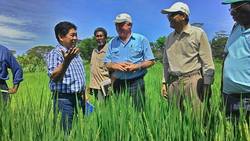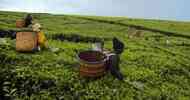Philippine Daily Inquirer | 4 February 2015
Papua New Guinea firm, local gov't keen on growing PH hybrid rice
by Ronnel W. Domingo
MANILA, Philippines–A private company and a local government in Papua New Guinea are keen on growing Philippine-sourced hybrid rice as a field trial being done by SL Agritech is dispelling the belief that rice cannot be grown in that country.
Frisco M. Malabanan, a consultant for SL Agritech Corp. (SLAC), said Papuan coffee exporter PNG Coffee Ltd. (PCL) was considering infusing investment in growing the SL-8H rice.
“We have already created massive awareness in Papua New Guinea on hybrid rice,” Malabanan said. “Our rice grains, due for harvest in March, are already filled.”
He said Village Garden PNG Ltd., the local company that was pilot testing the cultivation of different SLAC hybrid rice seeds, had opened its farm as technology demonstration area for observation.
He added that PCL chair Noreo Beangke had inspected the hybrid rice “in an interest to venture in the highly promising crop.”
Malabanan said the demo farm was expected to yield at least seven metric tons per hectare.
Also, government officials from the East Sepik province, which has 200,000 to 250,000 hectares of land that may potentially be planted to hybrid, have also expressed interest in planting rice.
“One of the demo farm’s visitors is a board member of the local parliament in East Sepik province,” Malabanan said.
According to Malabanan, Papua New Guinea, which traditionally imports about 300,000 tons of rice from Australia yearly, has noted the significant contribution that the Philippines is making to its rice sector even if it has its own National Agricultural Research Institute.
According to SLAC, the company is looking at business prospects related to a 300,000-hectare area for rice planting for Papuan consumption and for possible shipment to the Philippines.
Malabanan noted that the Department of Agriculture looked a few years ago at Papua New Guinea as a potential rice-growing area that could help support Philippine demand.
Malabanan said Papua New Guinea, with its vast land area suitable for rice planting, might become the Philippines’ source of rice.
He said that while there was no agricultural production yet in that country, there was ample supply of water for irrigation from rivers as well as ground water available just four to five meters below the ground.
Papua New Guinea firm, local gov't keen on growing PH hybrid rice
by Ronnel W. Domingo
MANILA, Philippines–A private company and a local government in Papua New Guinea are keen on growing Philippine-sourced hybrid rice as a field trial being done by SL Agritech is dispelling the belief that rice cannot be grown in that country.
Frisco M. Malabanan, a consultant for SL Agritech Corp. (SLAC), said Papuan coffee exporter PNG Coffee Ltd. (PCL) was considering infusing investment in growing the SL-8H rice.
“We have already created massive awareness in Papua New Guinea on hybrid rice,” Malabanan said. “Our rice grains, due for harvest in March, are already filled.”
He said Village Garden PNG Ltd., the local company that was pilot testing the cultivation of different SLAC hybrid rice seeds, had opened its farm as technology demonstration area for observation.
He added that PCL chair Noreo Beangke had inspected the hybrid rice “in an interest to venture in the highly promising crop.”
Malabanan said the demo farm was expected to yield at least seven metric tons per hectare.
Also, government officials from the East Sepik province, which has 200,000 to 250,000 hectares of land that may potentially be planted to hybrid, have also expressed interest in planting rice.
“One of the demo farm’s visitors is a board member of the local parliament in East Sepik province,” Malabanan said.
According to Malabanan, Papua New Guinea, which traditionally imports about 300,000 tons of rice from Australia yearly, has noted the significant contribution that the Philippines is making to its rice sector even if it has its own National Agricultural Research Institute.
According to SLAC, the company is looking at business prospects related to a 300,000-hectare area for rice planting for Papuan consumption and for possible shipment to the Philippines.
Malabanan noted that the Department of Agriculture looked a few years ago at Papua New Guinea as a potential rice-growing area that could help support Philippine demand.
Malabanan said Papua New Guinea, with its vast land area suitable for rice planting, might become the Philippines’ source of rice.
He said that while there was no agricultural production yet in that country, there was ample supply of water for irrigation from rivers as well as ground water available just four to five meters below the ground.














